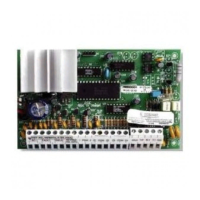6
Wire DEOL zones according to the following diagram:
NOTE: Do not wire DEOL resistors on keypad zones. Do not
use DEOL resistors for Fire zones or 24-hr Supervisory
zones.
NOTE: The DEOL option can only be selected if Normally
Closed (NC) detection devices or contacts are being used.
Only one NC contact can be connected to each zone. Wiring
multiple detection devices or contacts on a single loop is not
allowed.
NOTE: If the DEOL supervision option is enabled:
NOTE:• All hardwire zones on the main panel must be wired
for Double EOL resistors, except for Fire and 24-hr Supervi-
sory zones.
NOTE:• Do not wire Fire zones to keypad zone terminals.
The following chart shows zone status under certain condi-
tions:
Loop Resistance Loop Status
0Ω (shorted wire, loop shorted) Fault
5600Ω (contact closed) Secure
Infinite (broken wire, loop open) Tamper
11200Ω (contact open) Violated
End of Line Resistors . . . . . . . . . . . . . . . . . Section [013]: [1]
Double End of Line Resistors. . . . . . . . . . . Section [013]: [2]
2.9 Fire Zone Wiring
4-Wire Smoke Detectors
All fire zones must be wired according to the following dia-
gram:
2.10 GSM1000 Zone Wiring
GSM1000 Support
When using the GSM1000
cellular communicator,
connect the GSM1000 to
the main panel according
to the following diagram:
GSM1000 Supervision (24-hr Supervisory)
When using the GSM1000
cellular communicator, any
main board zone may be
configured for GSM1000
Supervision. Program this
zone as zone type [09], 24-
hr Supervisory in section
[001].
With a GSM1000 Supervi-
sory zone, if the GSM1000
experiences a trouble, the
zone will be violated, caus-
ing the panel to report the event to the central station. This
type of zone always requires a single EOL resistor (5600Ω).
Wire this zone according to the above diagram.
NOTE: When using the GSM1000, Busy Tone Detection must
not be used.
2.11 Keypad Zones
Each “z” keypad on the system has a zone input to which a
device - such as a door contact - can be connected. This
eliminates the need to run wires back to the control panel for
every device.
To install the keypad, open the keypad plastic by removing
the screw at the bottom of the unit. Locate the five terminals
on the keypad circuit board. Connect the four Keybus wires
from the control panel: the red wire to R, the black to B, the
yellow to Y and the green to G.
To connect the zone, run one wire to the Z terminal and the
other to B. For powered devices, use red and black to supply
power to the device. Run the red wire to the R (positive) ter-
minal and the black wire to the B (negative) terminal.
When using end of line supervision, connect the zone
according to one of the configurations outlined in section 2.8
“Zone Wiring”. End of line resistors must be placed on the
device end of the loop, not at the keypad.
NOTE: Keypad zones do not support DEOL resistors.
ANY Z
TERMINAL
ANY COM
TERMINAL
DOUBLE EOL CIRCUIT
1 NORMALLY CLOSED
CONTACT WITH 5600
END-OF-LINE RESISTORS

